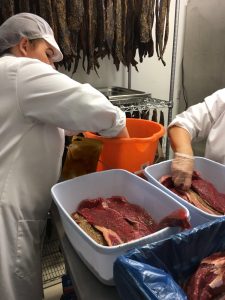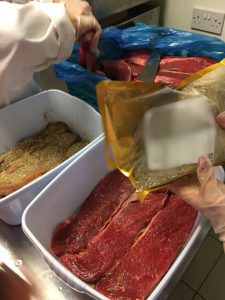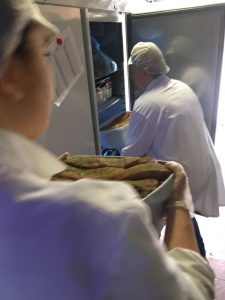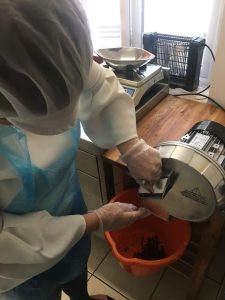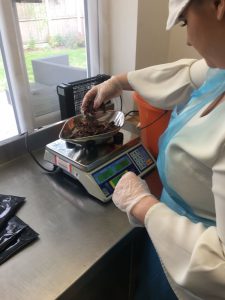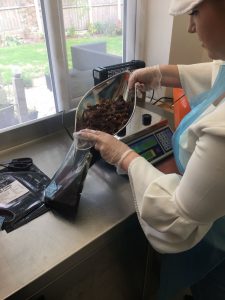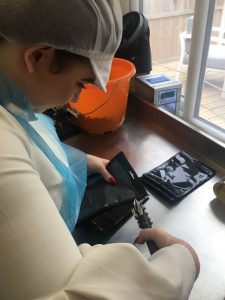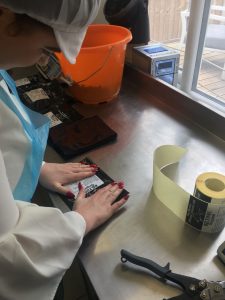In the Kitchen with The Weston Biltong Company #Producer Review
Briony Wilson
27th August 2018
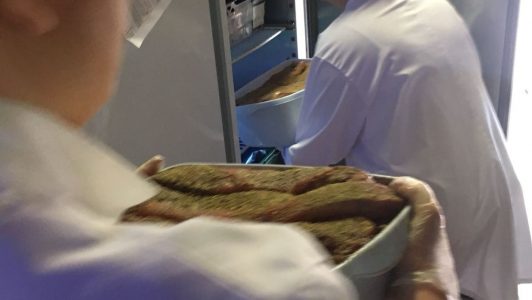
At Taste Cheshire we love to shout about the fabulous work that our local producers put in every week to make sure they have plenty of stock for all the events and stockist they need to supply each week, but how many of you actually know the process behind the product? This week we have been in the Kitchen with Sheryl from Weston Biltong, learning the ins and outs of making Biltong.
Sheryl and Ryan have been making Biltong now for 2 years growing there range from 12 wonderful flavours to 22. For those of you who don’t know biltong is; a form of dried, cured meat that originated in South Africa, various types of meat can be used but primarily beef is preferred in the UK market, that is what Weston use but watch this space… Once dried the meat is cut into strips following the grain of the muscle, it is a relation of Beef jerky as both are spiced, dried meats; however, the typical ingredients, taste and production processes often differ.
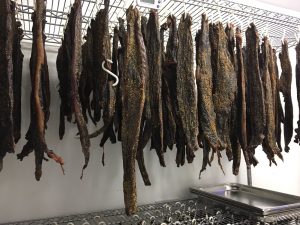 Ryan and Sheryl’s love for biltong developed on a family holiday to South Africa to visit the in laws and from there Ryan was treated to a hobby drier for a Birthday present, this developed from a hobby to a business idea quickly from there. When they started they were using 40 kilos of ‘wet’ meat a week, and now on an average week they are up to 250 kilos, just to meet demand. They make the product from home in Cheshire and over the past 24 months have gone to a lot of effort to keep it that way, converting most of their garage into a walk in drier and separate production room; I must acknowledge how they have transformed small space in to a highly efficient biltong unit, where everything has its place, not that we would expect anything else form Sheryl.
Ryan and Sheryl’s love for biltong developed on a family holiday to South Africa to visit the in laws and from there Ryan was treated to a hobby drier for a Birthday present, this developed from a hobby to a business idea quickly from there. When they started they were using 40 kilos of ‘wet’ meat a week, and now on an average week they are up to 250 kilos, just to meet demand. They make the product from home in Cheshire and over the past 24 months have gone to a lot of effort to keep it that way, converting most of their garage into a walk in drier and separate production room; I must acknowledge how they have transformed small space in to a highly efficient biltong unit, where everything has its place, not that we would expect anything else form Sheryl.
Before making our way into the production area we had to gear up in hairnets, gloves, white coats and shoe covers, we felt very official, next we went through the different equipment used and how each thing works. Due to the increase in production the team have had to scale things up and we got to see the variety of different dryers they have gone through to get to there current stage. The most efficient drier Ryan and Sherly use in racking they have assembled themselves with a series of fans to direct the airflow. The meat is hung in a particular way to maximise efficiency and dry the meat usually in 4-7 days depending on the size of the steaks used. The room uses a dehumidifier to draw out excess moisture from the air to enable the drying process and deter bacteria growth. I am afraid I have jumped a few stages I apologise.
Once the meat has arrived it is stored in Fridges until use, it arrives in large crates, which we transferred through to the production area, we then set up our station; a large tub filled with malt vinegar, and a second large tub which we sprinkled the spice mix in to create a layer of seasoning. The spice mix is a secret recipe mixed to Ryan and Sheryl’s specifications, many mixes differ but we used a base seasoning of Salt, Coriander, Sugar, Pepper and some natural preservatives. We then bathed the large silverside steaks in the vinegar to get a good coating but removing the excess before laying it in the tubs this helps to cleanse and tenderise the meat. We then coat it in the seasoning, we did this in a layering method of seasoning then meat, seasoning etc, until the tub was full, this is the most efficient way to flavour the meat and each bowl can fit up to 22-23kg in, before returning to the fridge for 24 hours to develop the flavours. This is just the base flavouring after this stage some varieties go through a second flavouring before being hung on the driers, however most go straight on to the custom-made driers which dries the meat through a constant air flow and very low heat. Depending on the size of the steaks, this can take between 4-7 days.
Once the meat is ready it is removed from the dryers and taken through to the production room for seasoning, cutting, bagging and sealing. The biltong we were making was there Original flavour so we didn’t need to add additional flavouring, but for the other 20 varieties that do, we once again add it to large tubs and leave it in the additional flavouring for another 12 hours. This biltong production is a lengthy process you know.
We went straight on to learning how to use the cutting machine, something that brought great fear to Tegan, oh ye of little faith. Due to the scale of production this is a motorised biltong cutting machine with a rotating blade that depending on the speed of insertion effects the thickness of the biltong thickness, and for Weston’s customers they prefer thinner slices, so it is important to take it nice and slow. From this stage we move on to weighing out the biltong into bags again using a mechanical stale, then the tricky bit (or at least for me) getting the biltong from the scales into the bag. Each bag has an oxygen absorber included to keep the texture and flavour of the meat as it should be. The bags are then heat sealed, using another fantastic piece of kit.
Finally, the last stage was adding the labels and the tear snip to each bag which must be done by hand, the biltong that we helped with was sold last weekend at the various market and events that the team attended.
We never realised for much care and attention went in to this wonderful product which I am munching away at as I type (Thanks Sheryl), I hope this has given you a bit more of an in site in to the world of biltong, and if you would like to read more of these type of features, please let us know.
The Weston Biltong Company
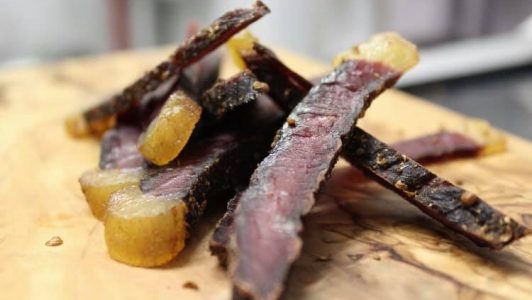
British Beef, marinated, dried and flavoured the traditional South African way to bring the delicacies of Biltong, Droewors and Boerewors to Cheshire.
More information